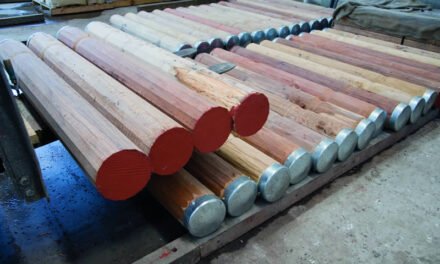Knowing the qualities of your timber, the abilities and limits of preservation techniques and the details of how it will be used are key to obtaining the required lifespan in your structure. By George Dolezal, principal engineer, Meyer Timber Pty Ltd.
Main image: This timber Oast House at Valleyfield, Tasmania, was built in the 1860s. (Shutterstock/Steve Lovegrove)
As a kid, we all wanted to be superheroes. They could do cool stuff, they always beat the baddies and, even though they often came close, rarely died. Imagine if we could transfer that to a piece of timber. Timber is a natural product and so has different abilities to last the test of time. But can we make it as durable as a superhero?
When we talk about Durable Timber what do we really mean? The definition of durable is ‘the ability to withstand wear, pressure, or damage’. For timber, there are really two main options to achieve this – either the timber needs to be naturally durable or it needs to be modified in some way to enhance its durability. But this also depends on the application and what level of wear and damage the timber is subjected to.
When considering the application, AS 1684 has an Appendix on durability that states that “timber used for house construction should have the level of durability appropriate for the relevant climate and expected service life and conditions”. It breaks this down into four major areas, which are:
- Internal, fully protected;
- External, above ground, protected;
- External, above ground, exposed;
- In-ground contact.
The first three above might be familiar to those with experience in glue laminated timber (GL, also known as GLT and glulam) as they correlate well to the Service Classes in the GL standard (AS/NZS 1328.1) which comes from the adhesive standard (AS/NZS 4364). After deciding on the location and conditions the timber will be exposed, you can either choose naturally durable timber or modify the timber somehow to suit.
All timber has a natural durability which has been rated and can be found in AS 1684 Appendix G. This gives a good indication, based on species, on how long it will last in different environments, as shown in Figure 1 (below). There are four durability classes where Class 1 has the highest durability and Class 4 has the lowest. There are also three applications of durability: internal fully protected, above ground exposed and in-ground contact/exposed to termites.

Modifying timber is most commonly done with preservative treatment. This is covered in AS/NZS 1604.1 and is broken into six Hazard Classes where H1 is indoor protected from borers, up to H6, which is prolonged immersion in sea water. The most common Hazard classes are H2S/F (indoor South of Tropic of Capricorn), H2 (indoor for whole of Australia), H3 (outdoor, above ground), H4 (outdoor in ground contact) and H5 (outdoor, in ground contact critical use).
When preservative treating to a Hazard Class in accordance with AS/NZS 1604.1 there are certain branding requirements, with the Timber Preservers Association of Australia (TPAA, www.tpaa.com.au) maintaining a register of treatment plants. They have also just started a voluntary certificate of compliance option in the register that will verify that treatment plants are getting regular testing done to comply with the retention levels in the standard.
Note that there are other ways to modify timber to enhance durability. These are within the sphere of individual companies that have patented processes such as thermal modification, acetylation, or densification and sell branded product.
So, for a Service Class 3 application you would be best to use a Durability Class 2 timber or otherwise one that has been treated to Hazard Class H3. This can be confusing as the number scales for these might seem to be opposite. A good way of remembering how this works is to think that the lower the number the less risk posed. So a Service Class 1 application or Hazard Class 1 poses little risk, and using a Durability Class 1 timber will result in minimal risk.
Now that we have that cleared up, how can we get a better understanding of what timber to use where and how long it will last? Remember that this all relies on an assessment of location and conditions and there could be situations where this may differ from the normal information provided. Untreated pine framing that is internal and protected is fine to use in Tasmania (where there is no termite risk), ‘blue pine’ (H2F) is suitable South of the Tropic of Capricorn and ‘red pine’ (H2) can be used anywhere in Australia. As it is internal-protected, this is based on the species of termite and decay does not come into the equation.
An H3 preservative-treated timber can be used as an example for deck joists, but if the deck was in a rainforest environment where it was continually damp with minimal direct sunlight, a higher level of preservative treatment would be required as this situation is different from the normal definitions.
There are a couple of good references to assist with specifying the right timber to ensure adequate outcomes. One of these is the Timber Service Life Design Guide (#5) which has been prepared by WoodSolutions (www.woodsolutions.com.au/publications/timber-service-life-design-guide). This guide drills right down into locations of interest for a specific application to give expected service life for both treated and untreated timber. As an example, you can get different service life expectancies for domestic decking for the top of the board, the underside where it is in contact with a joist, and the ends where they butt together on a joist (shown in Figure 2, below). This level of detail allows the specifier to make a well-informed decision on what timber species or what level of preservative treatment to use. In addition to life expectancy, the service life design guide contains information on design, detailing, finishing and maintenance. These in themselves are almost as important as the durability of the timber in creating successful outcomes. For instance, in outdoor exposed applications you should detail to allow moisture to drain away, and protect horizontal surfaces, joints (where possible) and end grain.

Another reference is the publication “Construction timbers in Queensland”. This has a digital version that can be found at https://qtimber.daf.qld.gov.au/. Similar to the WoodSolutions guide, this website allows you to specify the location, member type and exposure, and then select a timber. The website will let you know if that timber is suitable or what further treatment is required. Note that the QTimber website can be used for areas outside of Queensland, also, as the decay hazard zones are equivalent to the WoodSolutions guide.
So, in essence, you can get a long-lasting timber by either using its natural characteristics or modifying it to some degree based on where and how it will be used. If you combine this with good detailing and finishing, the timber will successfully last the test of time. This can be seen in numerous timber buildings which are still standing after being built over 1000 years ago. With a little bit of thought, your timber will behave just like the superhero we wanted to be. Except maybe Aquaman.
For more information on this topic, contact George Dolezal via email at GeorgeD@meyertimber.com.au












